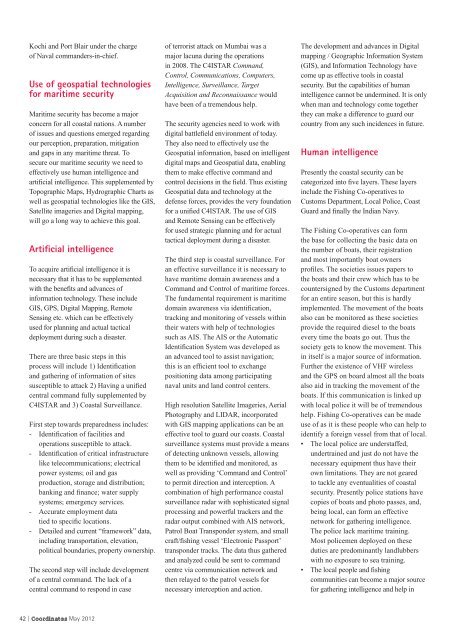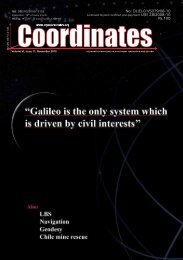Download - Coordinates
Download - Coordinates
Download - Coordinates
You also want an ePaper? Increase the reach of your titles
YUMPU automatically turns print PDFs into web optimized ePapers that Google loves.
Kochi and Port Blair under the charge<br />
of Naval commanders-in-chief.<br />
Use of geospatial technologies<br />
for maritime security<br />
Maritime security has become a major<br />
concern for all coastal nations. A number<br />
of issues and questions emerged regarding<br />
our perception, preparation, mitigation<br />
and gaps in any maritime threat. To<br />
secure our maritime security we need to<br />
effectively use human intelligence and<br />
arti cial intelligence. This supplemented by<br />
Topographic Maps, Hydrographic Charts as<br />
well as geospatial technologies like the GIS,<br />
Satellite imageries and Digital mapping,<br />
will go a long way to achieve this goal.<br />
Artifi cial intelligence<br />
To acquire arti cial intelligence it is<br />
necessary that it has to be supplemented<br />
with the bene ts and advances of<br />
information technology. These include<br />
GIS, GPS, Digital Mapping, Remote<br />
Sensing etc. which can be effectively<br />
used for planning and actual tactical<br />
deployment during such a disaster.<br />
There are three basic steps in this<br />
process will include 1) Identi cation<br />
and gathering of information of sites<br />
susceptible to attack 2) Having a uni ed<br />
central command fully supplemented by<br />
C4ISTAR and 3) Coastal Surveillance.<br />
First step towards preparedness includes:<br />
- Identi cation of facilities and<br />
operations susceptible to attack.<br />
- Identi cation of critical infrastructure<br />
like telecommunications; electrical<br />
power systems; oil and gas<br />
production, storage and distribution;<br />
banking and nance; water supply<br />
systems; emergency services.<br />
- Accurate employment data<br />
tied to speci c locations.<br />
- Detailed and current “framework” data,<br />
including transportation, elevation,<br />
political boundaries, property ownership.<br />
The second step will include development<br />
of a central command. The lack of a<br />
central command to respond in case<br />
42 | <strong>Coordinates</strong> May 2012<br />
of terrorist attack on Mumbai was a<br />
major lacuna during the operations<br />
in 2008. The C4ISTAR Command,<br />
Control, Communications, Computers,<br />
Intelligence, Surveillance, Target<br />
Acquisition and Reconnaissance would<br />
have been of a tremendous help.<br />
The security agencies need to work with<br />
digital battle eld environment of today.<br />
They also need to effectively use the<br />
Geospatial information, based on intelligent<br />
digital maps and Geospatial data, enabling<br />
them to make effective command and<br />
control decisions in the eld. Thus existing<br />
Geospatial data and technology at the<br />
defense forces, provides the very foundation<br />
for a uni ed C4ISTAR. The use of GIS<br />
and Remote Sensing can be effectively<br />
for used strategic planning and for actual<br />
tactical deployment during a disaster.<br />
The third step is coastal surveillance. For<br />
an effective surveillance it is necessary to<br />
have maritime domain awareness and a<br />
Command and Control of maritime forces.<br />
The fundamental requirement is maritime<br />
domain awareness via identi cation,<br />
tracking and monitoring of vessels within<br />
their waters with help of technologies<br />
such as AIS. The AIS or the Automatic<br />
Identi cation System was developed as<br />
an advanced tool to assist navigation;<br />
this is an ef cient tool to exchange<br />
positioning data among participating<br />
naval units and land control centers.<br />
High resolution Satellite Imageries, Aerial<br />
Photography and LIDAR, incorporated<br />
with GIS mapping applications can be an<br />
effective tool to guard our coasts. Coastal<br />
surveillance systems must provide a means<br />
of detecting unknown vessels, allowing<br />
them to be identi ed and monitored, as<br />
well as providing ‘Command and Control’<br />
to permit direction and interception. A<br />
combination of high performance coastal<br />
surveillance radar with sophisticated signal<br />
processing and powerful trackers and the<br />
radar output combined with AIS network,<br />
Patrol Boat Transponder system, and small<br />
craft/ shing vessel ‘Electronic Passport’<br />
transponder tracks. The data thus gathered<br />
and analyzed could be sent to command<br />
centre via communication network and<br />
then relayed to the patrol vessels for<br />
necessary interception and action.<br />
The development and advances in Digital<br />
mapping / Geographic Information System<br />
(GIS), and Information Technology have<br />
come up as effective tools in coastal<br />
security. But the capabilities of human<br />
intelligence cannot be undermined. It is only<br />
when man and technology come together<br />
they can make a difference to guard our<br />
country from any such incidences in future.<br />
Human intelligence<br />
Presently the coastal security can be<br />
categorized into ve layers. These layers<br />
include the Fishing Co-operatives to<br />
Customs Department, Local Police, Coast<br />
Guard and nally the Indian Navy.<br />
The Fishing Co-operatives can form<br />
the base for collecting the basic data on<br />
the number of boats, their registration<br />
and most importantly boat owners<br />
pro les. The societies issues papers to<br />
the boats and their crew which has to be<br />
countersigned by the Customs department<br />
for an entire season, but this is hardly<br />
implemented. The movement of the boats<br />
also can be monitored as these societies<br />
provide the required diesel to the boats<br />
every time the boats go out. Thus the<br />
society gets to know the movement. This<br />
in itself is a major source of information.<br />
Further the existence of VHF wireless<br />
and the GPS on board almost all the boats<br />
also aid in tracking the movement of the<br />
boats. If this communication is linked up<br />
with local police it will be of tremendous<br />
help. Fishing Co-operatives can be made<br />
use of as it is these people who can help to<br />
identify a foreign vessel from that of local.<br />
• The local police are understaffed,<br />
undertrained and just do not have the<br />
necessary equipment thus have their<br />
own limitations. They are not geared<br />
to tackle any eventualities of coastal<br />
security. Presently police stations have<br />
copies of boats and photo passes, and,<br />
being local, can form an effective<br />
network for gathering intelligence.<br />
The police lack maritime training.<br />
Most policemen deployed on these<br />
duties are predominantly landlubbers<br />
with no exposure to sea training.<br />
• The local people and shing<br />
communities can become a major source<br />
for gathering intelligence and help in
















